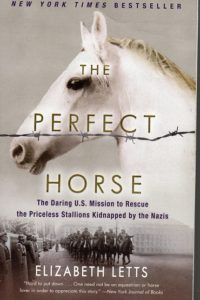Book Review: The Perfect Horse by Elizabeth Letts
Disclaimer: I received this book as a Goodreads giveaway to facilitate this review. No other compensation was offered or requested.
The year is 1945. The war in Europe is almost over. American troops learn that a stud farm in Hostau contains horses looted by the Nazis from all over Europe, including all the mares of the famous Lipizzaners of Austria, the pride of the Spanish Riding School. Unless something is done to ensure the area is captured peacefully, the cream of Europe’s equine population will be at risk of destruction in the fighting.
There’s a huge problem standing in the way; Hostau is on the other side of the Czechoslovakian border, where the U.S. Army has been forbidden to trespass. Can the 2nd Cavalry convince command to make an exception in time? Even if they do, can they pull it off with minimal bloodshed?
That mission is the centerpiece of this volume, but there’s considerable material both before and after it. Author Elizabeth Letts is an equestrian herself, and it really shows in the descriptions of the bond between rider and mount. There are also quite a few black and white illustrations that give context to the story.
One of the central figures of this history is Alois Podhajsky, introduced riding dressage for the Austrian team during the 1936 Berlin Olympics before taking the reins of the Spanish Riding School in Vienna. A great lover of horses, especially the Lipizzaner, he did what he had to do to preserve the horses and the riding school, even if it meant abandoning the school building to save the stallions.
On the American side, there’s Colonel Hank Reed, cavalry commander from the days when they had been horse soldiers (not that long before–it was 1942 when the U.S. decided to make their cavalry completely mechanized!) He was fully aware of the value of what might be lost if Hostau was not captured without a battle, and was the one to order the mission.
But there are plenty of other humans involved. Gustav Rau was Nazi Germany’s Master of Horse, and believed that he could breed a perfect horse, superior in battle, and destined to aid the Third Reich in conquering the world. (Since he was a civilian and not involved in any war crimes against humans, he got off scot-free at the end of the war. Information that has come out since has made his legacy more controversial.)
Rudolph Lessing was a German Army veterinarian who’d spent the first few years of the war fighting on the Eastern Front. It wasn’t until he was pulled back to Occupied Poland that he realized just what atrocities were happening and that his country might not be the good guys in this conflict.
And of course General George S. Patton, America’s Fightin’est General, who sort of authorized the Hostau mission, in the Mission: Impossible sense. “If you are captured or killed, Command will disavow any knowledge of your actions.” He, too, was a man who appreciated a fine horse, and also helped out the stallions of the Spanish Riding School.
Of course, just capturing the stud farm didn’t actually make the horses safe, and they then had to be moved to better locations. Some went home to the countries they’d been stolen from (and the Spanish Riding School exists to this day), others made the perilous sea voyage to America, and some found homes wherever they were.
There’s an epilogue section that details the final fates of the major figures in the story, both horses and men. There are endnotes (including notes on when the sources used contradict each other), a bibliography and full index.
The book is movingly written and will be appreciated both by horse lovers and World War Two buffs. There is some discussion of disturbing material, but this book should be suitable for senior high readers on up.
Older readers may be thinking, “wait, wasn’t there a Disney TV movie about this?” Yes, there was. The Miracle of the White Stallions was released in the early 1960s. It was, of course, somewhat loose with the historical facts, but here’s the trailer.

